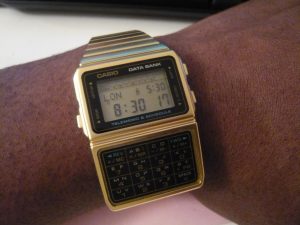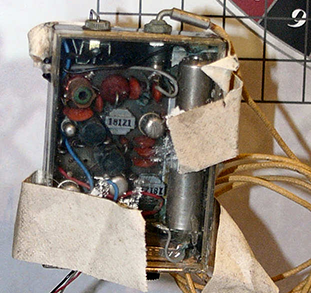Wearable technology has been around longer than you think. It’s not all VR goggles and fitness bands.

Early wearable technology was first seen in around 1966 with the invention of a device about the size of a cigarette packet that strapped to a wrist and measured the speed of a roulette wheel transmitting its predictions to an earpiece – (https://www.cs.virginia.edu/~evans/thorp.pdf).
Years later saw the first real success of wearable technology and it was in the form of the Casio Databank watch from 1984. A watch that could store contact information and went on to sell almost 6 million units (http://www.igi-global.com/article/a-forecast-of-the-adoption-of-wearable-technology/130676).
The Sony Walkman player, another wearable device, allowed wearers to listen to their music outside of the home via tape cassette.
Fast forward 30 years and we are here, in a sea of wearable mp3 players, smart watches, fitness bands and virtual reality goggles and the question for me is… how can we implement this technology to enhance medical learning and education?
These ongoing posts aim to explore current applications of technology in education, its perceived success, and to look at predictions on where this ever changing mode of tech may be heading.
Anything I find of interest to talk about in posts will be collated here – https://uk.pinterest.com/carmichael0071/wearable-technology/
What shall I wear?
Spoilt for choice much? Currently there are a number of VR wearables. Occulus Rift, Google Glass, Samsung VR Gear, along with Sony’s and Microsofts offerings. Then there are fitness bands, Jawbone, Fitbit, Nike Fuel and the Microsoft band. Not to mention numerous other wearables like –
Valedo back pain therapy – http://www.valedotherapy.com/?___store=hocoma_de_en&___from_store=hocoma_de_de)
Health Patch MD – http://www.vitalconnect.com/healthpatch-md
Quell pain relief -https://www.quellrelief.com/product
These are all good examples of wearable tech yet they are all aimed at the consumer. I want tech for the classroom, tech for the students. Tech that will help medical student’s realise their potential and help quantify their understanding of key elements of the curriculum. Can this even be achieved? Is there affordable tech that the whole class can use in unison or is there a piece that each have to wait in turn to use?
Google glass seemed promising a few years ago but has recently gone quiet. Some surgeons used them to film surgery so students can watch via a live stream but ultimately it was never picked up by the wider public.
This highlights the dangers of wearable tech, there can be a lot of interest and awe drummed up prior to a product launch but the testing factor is longevity, is this tech just a fad?or are there real world uses that these devices will conquer and become integrated into our normal way of life?.
If you think about mobiles, if someone said 30 years ago that you will soon have a device that fits in your pocket that contains more tech than a NASA astronaut had when exploring the moon that will give you access to nearly anything you wanted to know via the internet yet will be mostly used to look at cats doing funny things and arguing with strangers about whether the new series of The Walking Breaking Bad Game of Thrones is best.
What if now some of these items of wearable tech are the beginnings of something similar? Something that will eventually be so common place in our lives that we use it without even thinking about it, like second nature, like how a lot us now treat our phones. I’m sure I’m not the only person when leaving the house thinks to myself, wallet, keys, phone…check. What if in the future that last minute departure checklist consisted of Wallet, keys, phone, health band, AR headset….check?
It’s not impossible. It’s already happening, and it’s been happening for a while.

